A Methodological Approach to the Teaching STEM Skills in Latin America through Educational Robotics for School Teachers
Abstract
:1. Introduction
2. Background
2.1. Educational Robotics
2.2. Gender in Educational Robotics
2.3. Arduino-Assisted Robotics Coding Applications
2.4. Methodologies for Teaching ER
3. Methodology
3.1. Study Group
3.2. Data Collection Tools
3.3. Implement of the Research
3.3.1. Workshop 1: Interactive Stories
3.3.2. Workshop 2: Medical Sciences and Electronics
3.3.3. Workshop 3: Interactive Toy
3.3.4. Workshop 4: Music and Electronics
3.3.5. Workshop 5: Smart Planter
4. Data Analysis
5. Discussion and Conclusions
6. Limitations
Funding
Conflicts of Interest
References
- Cheryan, S.; Master, A.; Meltzoff, A.N. Cultural stereotypes as gatekeepers: Increasing girls’ interest in computer science and engineering by diversifying stereotypes. Front. Psychol. 2015, 6, 49. [Google Scholar] [CrossRef] [PubMed] [Green Version]
- Margolis, J.; Fisher, A.; Miller, F. The Anatomy of Interest: Women in Undergraduate Computer Science. Women’s Stud. Q. 2000, 28, 104–127. [Google Scholar]
- Dasgupta, N. Ingroup experts and peers as social vaccines who inoculate the self-concept: The stereotype inoculation model. Psychol. Inq. 2011, 22, 231–246. [Google Scholar] [CrossRef]
- Rudman, L.A. Self-promotion as a risk factor for women: The costs and benefits of counter stereotypical impression management. J. Personal. Soc. Psychol. 1998, 74, 629–645. [Google Scholar] [CrossRef]
- Roberta Iniciative. Available online: https://lab.open-roberta.org/ (accessed on 15 December 2021).
- WSTEM Project. Available online: https://wstemproject.eu/ (accessed on 27 October 2021).
- Benavent, X.; De Ves, E.; Forte, A.; Botella-Mascarell, C.; López-Iñesta, E.; Rueda, S.; Roger, S.; Perez, J.; Portalés, C.; Dura, E.; et al. Girls4STEM: Gender Diversity in STEM for a Sustainable Future. Sustainability 2020, 12, 6051. [Google Scholar] [CrossRef]
- Herro, D.; Quigley, C.; Jacques, L. Examining technology integration in middle school STEAM units. Technol. Pedagog. Educ. 2018, 7, 485–498. [Google Scholar] [CrossRef]
- Chang, D.F.; Chang Tzeng, H.C. Patterns of gender parity in the humanities and STEM programs: The trajectory under the expanded higher education system. Stud. High. Educ. 2018, 45, 1108–1120. [Google Scholar] [CrossRef]
- UNESCO: Science Report: Towards 2030. Available online: https://en.unesco.org/sites/default/files/usr15_is_the_gender_gap_narrowing_in_science_and_engineering.pdf (accessed on 15 October 2021).
- García-Holgado, A.; Camacho Díaz, A.; García-Peñalvo, F.J. La brecha de género en el sector STEM en América Latina: Una propuesta europea. In Actas del V Congreso Internacional sobre Aprendizaje, Innovación y Competitividad; Sein-Echaluce Lacleta, M.L., Fidalgo-Blanco, Á., García-Peñalvo, F.J., Eds.; Servicio de Publicaciones Universidad de Zaragoza: Zaragoza, Spain, 2019; pp. 704–709. [Google Scholar]
- Skaalvik, S.; Skaalvik, E.M. Gender Differences in Math and Verbal Self-Concept, Performance Expectations, and Motivation. Sex Roles 2004, 50, 241–252. [Google Scholar] [CrossRef]
- Margot, K.C.; Kettler, T. Teachers’ perception of STEM integration and education: A systematic literature review. Int. J. STEM Educ. 2019, 6, 2. [Google Scholar] [CrossRef] [Green Version]
- Zhang, Y.; Luo, R.; Zhu, Y.; Yin, Y. Educational Robots Improve K-12 Students’ Computational Thinking and STEM Attitudes: Systematic Review. J. Educ. Comput. Res. 2021, 59, 1450–1481. [Google Scholar] [CrossRef]
- Mussati, A.; Giang, C.; Piatti, A.; Mondada, F. A Tangible Programming Language for the Educational Robot Thymio. In Proceedings of the 2019 10th International Conference on Information, Intelligence, Systems and Applications (IISA), Patras, Greece, 15–17 July 2019; pp. 1–4. [Google Scholar] [CrossRef]
- Chevalier, M.; Giang, C.; Piatti, A.; Mondada, F. Fostering computational thinking through educational robotics: A model for creative computational problem solving. Int. J. STEM Educ. 2020, 7, 39. [Google Scholar] [CrossRef]
- Sullivan, A.; Bers, M. VEX Robotics Competitions: Gender Differences in Student Attitudes and Experiences. J. Inf. Technol. Educ. Res. 2019, 18, 97–112. [Google Scholar] [CrossRef] [Green Version]
- McIlwee, J.S.; Robinson, J.G. Women in Engineering: Gender, Power, and Workplace Culture; SUNY Press: New York, NY, USA, 1992. [Google Scholar]
- Sullivan, A.; Bers, M.U. The impact of teacher gender on girls’ performance on programming tasks in early elementary school. J. Inf. Technol. Educ. Innov. Pract. 2018, 17, 153–162. [Google Scholar] [CrossRef]
- Román-Graván, P.; Hervás-Gómez, C.; Martín-Padilla, A.H.; Fernández-Márquez, E. Perceptions about the Use of Educational Robotics in the Initial Training of Future Teachers: A Study on STEAM Sustainability among Female Teachers. Sustainability 2020, 12, 4154. [Google Scholar] [CrossRef]
- Peixoto, A.; Castro, M.; Blaz, M.; Martin, S.; Sancristobal, E.; Carro, G.; Plaza, P. Robotics tips and tricks for inclusion and integration of students. In Proceedings of the 2018 IEEE Global Engineering Education Conference (EDUCON), Santa Cruz de Tenerife, Spain, 17–20 April 2018; pp. 2037–2041. [Google Scholar] [CrossRef]
- Cuartielles, D.; Iriepa, N.; Rodriguez, C.; Lopez, E.; Garcia, J. Educational Robots with Arduino: Annotated Prototypes. In Educational Robotics in the Context of the Maker Movement; Moro, M., Alimisis, D., Iocchi, L., Eds.; Edurobotics 2018: Advances in Intelligent Systems and Computing; Springer: Cham, Switzerland, 2020; Volume 946. [Google Scholar] [CrossRef]
- Ntourou, V.; Kalogiannakis, M.; Psycharis, S. A Study of the Impact of Arduino and Visual Programming in Self-Efficacy, Motivation, Computational Thinking and 5th Grade Students’ Perceptions on Electricity. Eurasia J. Math. Sci. Technol. Educ. 2021, 17, em1960. [Google Scholar] [CrossRef]
- Abidin, Z.; Arifudin, R.; Hardyanto, W.; Akhlis, I.; Umer, R.; Kurniawan, N. Low-cost educational robotics for promoting STEM education. J. Phys. Conf. Ser. 2021, 1918, 042018. [Google Scholar] [CrossRef]
- Dimitriou, K. A more structured way to teach robotics with robotics. In Proceedings of the 3rd International Workshop Teaching Robotics, Teaching with Robotics Integrating Robotics in School Curriculum, Trento, Italy, 20 April 2012; pp. 163–169. [Google Scholar]
- de Azevedo, S.O.; Bezerra, J.E.; de Miranda, L.C. A methodology of contextualized educational robotics. In Proceedings of the 2017 IEEE Frontiers in Education Conference (FIE), Indianapolis, IN, USA, 18–21 October 2017; pp. 1–9. [Google Scholar] [CrossRef]
- Angel-Fernandez, J.M.; Vincze, M. Towards a Definition of Educational Robotics. In Proceedings of the Processing Austrian Robot Workshop, Innsbruck, Austria, 17–18 May 2018; pp. 37–42. [Google Scholar] [CrossRef]
- Papert, S. Teaching Children Thinking. Program. Learn. Educ. Technol. 1972, 9, 245–255. [Google Scholar] [CrossRef]
- Solomon, C.J.; Papert, S. A Case Study of a Young Child Doing Turtle Graphics in Logo. Massachusetts Institute of Technology. Cambridge Artificial Intelligence Lab. National Institute of Education. 1976. Available online: https://files.eric.ed.gov/fulltext/ED207578.pdf (accessed on 16 October 2021).
- Papert, S. Mindstorm: Children, Computers, and Powerful Ideas; Basic Books, Inc.: New York, NY, USA, 1980. [Google Scholar]
- Rush, M.N.; Resnick, R.B.; Pezalla-Granlund, M. New pathways into robotics: Strategies for broadening participation. J. Sci. Educ. Technol. 2008, 17, 59–69. [Google Scholar]
- American Association of University Women (AAUW). Executive Summary: Tech-Savvy: Educating Girls in the New Computer Age [Electronic Version]; American Association of University Women (AAUW): Washington, DC, USA, 2000. [Google Scholar]
- Plaza, P.; Sancristobal, E.; Carro, G.; Blazquez, M.; García-Loro, F.; Martin, S.; Perez, C.; Castro, M. Arduino as an Educational Tool to Introduce Robotics. In Proceedings of the 2018 IEEE International Conference on Teaching, Assessment, and Learning for Engineering (TALE), Wollongong, NSW, Australia, 4–7 December 2018; pp. 1–8. [Google Scholar] [CrossRef]
- Xenabis, A.; Brentas, S. STEM activities based on educational robotics, recyclable materials and Arduino Programming. In Proceedings of the Edulearn19 Proceedings 11th International Conference on Education and New Learning Technologies, Palma, Spain, 1–3 July 2019; pp. 1443–1452. [Google Scholar]
- Junior, L.A.; Neto, O.T.; Hernandez, M.D.; Martins, P.S.; Roger, L.B.; Guerra, F. A Low-Cost and Simple Arduino-Based Educational Robotics Kit. Cyber J. Multidiscip. J. Sci. Technol. J. Sel. Areas Robot. Control 2013, 3, 1–7. [Google Scholar]
- Charoula, A.; Nicos, V. Developing young children’s computational thinking with educational robotics: An interaction effect between gender and scaffolding strategy. Comput. Hum. Behav. 2020, 105, 105954. [Google Scholar] [CrossRef]
- Eguchi, A. RoboCupJunior for promoting STEM education, 21st century skills, and technological advancement through robotics competition. Robot. Auton. Syst. 2016, 75, 696–699. [Google Scholar] [CrossRef]
- Barker, B.; Ansorge, J. Robotics as means to increase achievement scores in an informal learning environment. J. Res. Technol. Educ. 2007, 39, 229–243. [Google Scholar] [CrossRef]
- Hussain, S.; Lindh, J.; Shukur, G. The effect of LEGO training on pupils’s school performance in mathematics, problem solving ability and attitude: Swedish data. Educ. Technol. Soc. 2006, 9, 182–194. [Google Scholar]
- Nugent, G.; Barker, B.; Grandgenett, N. The effect of 4-H robotics and geospatial technologies on science, technology, engineering, and mathematics learning and attitudes. In Proceedings of the EdMedia: World Conference on Educational Media and Technology, Vienna, Austria, 30 June 2008; Volume 2008, pp. 447–452. [Google Scholar]
- Altin, H.; Pedaste, M. Learning approaches to applying robotics in science education. J. Balt. Sci. Educ. 2013, 12, 365–377. [Google Scholar]
- Jurado, E.; Fonseca, D.; Coderch, J.; Canaleta, X. Social STEAM Learning at an Early Age with Robotic Platforms: A Case Study in Four Schools in Spain. Sensors 2020, 20, 3698. [Google Scholar] [CrossRef] [PubMed]
- Sullivan, A.; Bers, M.U. Girls, boys, and bots: Gender differences in young children’s performance on robotics and programming tasks. J. Inf. Technol. Educ. Innov. Pract. 2016, 15, 145–165. Available online: http://www.informingscience.org/Publications/3547 (accessed on 16 December 2021). [CrossRef] [Green Version]
- Vavassoru, B.; Barreto, F. Exploring the educational potential of robotics in schools: A systematic review. Comput. Educ. 2012, 58, 978–988. [Google Scholar] [CrossRef]
- Alves-Oliveira, P. Boosting Children’s Creativity through Creative Interactions with Social Robots. Ph.D. Thesis, University Institute of Lisbon, Lisbon, Portugal, 2020. [Google Scholar]
- Sapounidis, T.; Demetriadis, S.N. Exploring children’s preferences regarding tangible and graphical tools for introductory programming: Evaluating the PROTEAS kit. In Proceedings of the 12th IEEE International Conference on Advanced Learning Technologies, Rome, Italy, 4–6 July 2012; pp. 316–320. [Google Scholar]
- Jennifer, B.; Debra, G. When Do Girls Lose Interest in Math and Science? Science Sampler. 2008. Available online: https://sc.lib.miamioh.edu/bitstream/handle/2374.MIA/5965/2008%20-%20When%20Do%20Girls%20Lose%20Interest%20in%20Math%20and%20Science%3f.pdf?sequence=1&isAllowed=y (accessed on 16 December 2021).
- Murphy, M.C.; Steele, C.M.; Gross, J.J. Signaling threat: How situational cues affect women in math, science, and engineering settings. Psychol. Sci. 2007, 18, 879–885. [Google Scholar] [CrossRef] [PubMed]
- Master, A.; Cheryan, S.; Meltzoff, A.N. Reducing adolescent girls’ concerns about STEM stereotypes: When do female teachers matter? Int. Rev. Soc. Psychol. 2014, 27, 79–102. [Google Scholar]
- Hughes, R.; Schellinger, J.; Roberts, K. The role of recognition in disciplinary identity for girls. J. Res. Sci. Teach. 2021, 58, 420–455. [Google Scholar] [CrossRef]
- Merdan, M.; Lepuschitz, W.; Koppensteiner, G.; Balogh, R. (Eds.) Robotics in Education: Research and Practices for Robotics in STEM Education, 7th ed.; Springer: Vienna, Austria; Cham, Switzerland, 2016; Volume 457. [Google Scholar]
- Arduino. Available online: https://www.arduino.cc/ (accessed on 16 December 2021).
- Dokmetas, G. Arduino Training Book; Dikey Eksen Yayincilik: Istanbul, Turkey, 2016. [Google Scholar]
- Patiño-Escarcina, R.E.; Barrios-Aranibar, D.; Bernedo-Flores, L.S.; Alsina, P.J.; Gonçalves, L.M. A Methodological Approach to the Learning of Robotics with EDUROSC-Kids. J. Intell. Robot. Syst. 2021, 102, 34. [Google Scholar] [CrossRef] [PubMed]
- Vygotsky, L.S. Mind and Society: The Development of Higher Mental Processes; Harvard University Press: Cambridge, UK, 1978. [Google Scholar]
- Barak, M.; Zadok, Y. Robotics projects and learning concepts in science, technology and problem solving. Int. J. Technol. Des. Educ. 2009, 19, 289–307. [Google Scholar] [CrossRef]
- Doleck, T.; Bazelais, P.; Lemay, D.J.; Saxena, A.; Basnet, R.B. Algorithmic thinking, cooperativity, creativity, critical thinking, and problem solving: Exploring the relationship between computational thinking skills and academic performance. J. Comput. Educ. 2017, 4, 355–369. [Google Scholar] [CrossRef]
- Kazakoff, E.R.; Sullivan, A.; Bers, M.U. The effect of a classroom-based intensive robotics and programming workshop on sequencing ability in early childhood. Early Child. Educ. J. 2013, 41, 245–255. [Google Scholar] [CrossRef]
- Blanchard, S.; Freiman, V.; Lirrete-Pitre, N. Strategies used by elementary schoolchildren solving robotics-based complex tasks: Innovative potential of technology. Proc. Soc. Behav. Sci. 2010, 2, 2851–2857. [Google Scholar] [CrossRef] [Green Version]
- Miller, D.; Nourbakhsh, I.; Siegwart, R. Robots for Education in Handbook of Robotics; Springer: Berlin/Heidelberg, Germany, 2008; pp. 1283–1301. [Google Scholar] [CrossRef]
- Sullivan, F.R. Serious and Playful Inquiry: Epistemological Aspects of Collaborative Creativity. Educ. Technol. Soc. 2011, 14, 55–65. [Google Scholar]
- Atmatzidou, S.; Demetriadis, S. Advancing students’ computational thinking skills through educational robotics: A study on age and gender relevant differences. Robot. Auton. Syst. 2016, 75, 661–670. [Google Scholar] [CrossRef]
- Alimisis, D. Teacher Education on Robotics-Enhanced Constructivist Pedagogical Methods; School of Pedagogical and Technological Education (ASPETE): Athens, Greece, 2009. [Google Scholar]
- González-Fernández, M.O.; Flores-González, Y.A.; Muñoz-López, C. Panorama de la robótica educativa a favor del aprendizaje STEAM. Rev. Eureka Enseñanza Divulg. Cienc. 2021, 18, 2301. [Google Scholar] [CrossRef]
- Von Wangenheim, A.; Gresse von Wangenheim, C.; Pacheco, F.S.; Hauck, J.C.R.; Ferreira, M.N.F. Motivating Teachers to Teach Computing in Middle School – A Case Study of a Physical Computing Taster Workshop for K-12 Teachers. Int. J. Comput. Sci. Educ. Sch. 2017, 1, 35–49. [Google Scholar] [CrossRef]
- Major, L.; Kyriacou, T.; Brereton, P. The effectiveness of simulated robots for supporting the learning of introductory programming: A multi-case case study. Comput. Sci. Educ. 2014, 24, 193–228. [Google Scholar] [CrossRef] [Green Version]
- Goodale, T.A. The influence of a ROV themed engineering design workshop on in-service teacher self-efficacy. In Proceedings of the 2013 IEEE Integrated STEM Education Conference (ISEC), Princeton, NJ, USA, 9 March 2013; pp. 1–5. [Google Scholar] [CrossRef]
- Schina, D.; Esteve-González, V.; Usart, M. An overview of teacher training programs in educational robotics: Characteristics, best practices and recommendations. Educ. Inf. Technol. 2021, 26, 2831–2852. [Google Scholar] [CrossRef]
- Bybee, R.; Landes, N.M. Science for life and living: An elementary school science program from Biological Sciences Improvement Study (BSCS). Am. Biol. Teach. 1990, 52, 92–98. [Google Scholar] [CrossRef]
- Cross, J.; Hamner, E.; Zito, L.; Nourbakhshh, I.; Bernstein, D. Development of an assessment for measuring middle school student attitudes towards robotics activities. In Proceedings of the IEEE Frontiers in Education Conference (FIE), Erie, PA, USA, 12–15 October 2016; pp. 1–8. [Google Scholar]
- Horn, M.S.; Solovey, E.T.; Crouser, R.J.; Jacob, R.J. Comparing the use of tangible and graphical programming languages for informal science education. In Proceedings of the SIGCHI Conference on Human Factors in Computing Systems (CHI ‘09), Association for Computing Machinery, New York, NY, USA, 4–9 April 2009; pp. 975–984. [Google Scholar] [CrossRef] [Green Version]
- Su, R.; Rounds, J.; Armstrong, P.I. Men and things, women and people: A meta-analysis of sex differences in interests. Psychol. Bull. 2009, 135, 859–884. [Google Scholar] [CrossRef]
- Yamtinah, S.; Masykuri, M.; Ashadi Shidiq, A.S. Gender differences in students’ attitudes toward science: An analysis of student’s science process skill using testlet instrument. AIP Conf. Proc. 2017, 1868, 030003. [Google Scholar] [CrossRef] [Green Version]
- Makarova, E.; Aeschlimann, B.; Herzog, W. The Gender Gap in STEM Fields: The Impact of the Gender Stereotype of Math and Science on Secondary Students’ Career Aspirations. Front. Educ. 2019, 4, 60. [Google Scholar] [CrossRef]
- Lucio, N.; Christian, G. How do pupils perceive educational robotics as a tool to improve their 21st century skills? J. Learn. Knowl. Soc. 2019, 15, 77–87. [Google Scholar] [CrossRef]
- Shaqiri, A.; Roinishvili, M.; Grzeczkowski, L.; Chkonia, E.; Pilz, K.; Mohr, C.; Brand, A.; Kunchulia, M.; Herzog, M.H. Sex-related differences in vision are heterogeneous. Sci. Rep. 2018, 8, 7521. [Google Scholar] [CrossRef]
- Balland, C.; Cissé, N.S.; Hergoualćh, L.; Kervot, G.; Lidec, A.; Machard, A.; Ribaud-Le Cann, L.; Rio, C.; Sinilo, M.; Dantec, V.; et al. Girls Who Do Scratch a First Round with the Essence Kernel. In Proceedings of the 2017 IEEE 30th Conference on Software Engineering Education and Training (CSEE), Savannah, GA, USA, 7–9 November 2017. [Google Scholar]
- Jiang, B.; Li, Z. Effect of Scratch on computational thinking skills of Chinese primary school students. J. Comput. Educ. 2021, 8, 505–525. [Google Scholar] [CrossRef]
- Statter, D.; Armoni, M. Teaching Abstract Thinking in Introduction to Computer Science for 7th Graders. In Proceedings of the 11th Workshop in Primary and Secondary Computing Education, Münster, Germany, 13–15 October 2016; pp. 80–83. [Google Scholar] [CrossRef]
- Gibbons, S.J.; Hirsch, L.S.; Kimmel, H.; Rockland, R.; Bloom, J. MIDDLE School Students’ Attitudes to and Knowledge about Engineering. In Proceedings of the International Conference on Engineering Education, Gainesville, FL, USA, 16–21 October 2004. [Google Scholar]
- Parsazadeh, N.; Cheng, P.-Y.; Wu, T.-T.; Huang, Y.-M. Integrating Computational Thinking Concept into Digital Storytelling to Improve Learners’ Motivation and Performance. J. Educ. Comput. Res. 2021, 59, 470–495. [Google Scholar] [CrossRef]
- Hoić-Božić, N.; Dlab, M.H.; Budim, S.U.; Mezak, J. Development of computational thinking skills in primary school through digital storytelling with Scratch. In Proceedings of the 10th International Conference on e-Learning, Belgrade, Serbia, 26–27 September 2019; pp. 114–119. [Google Scholar]
- Zint, M. Comparing three attitude-behavior theories for predicting science teachers’ intentions. J. Res. Sci. Teach. 2002, 39, 819–844. [Google Scholar] [CrossRef] [Green Version]

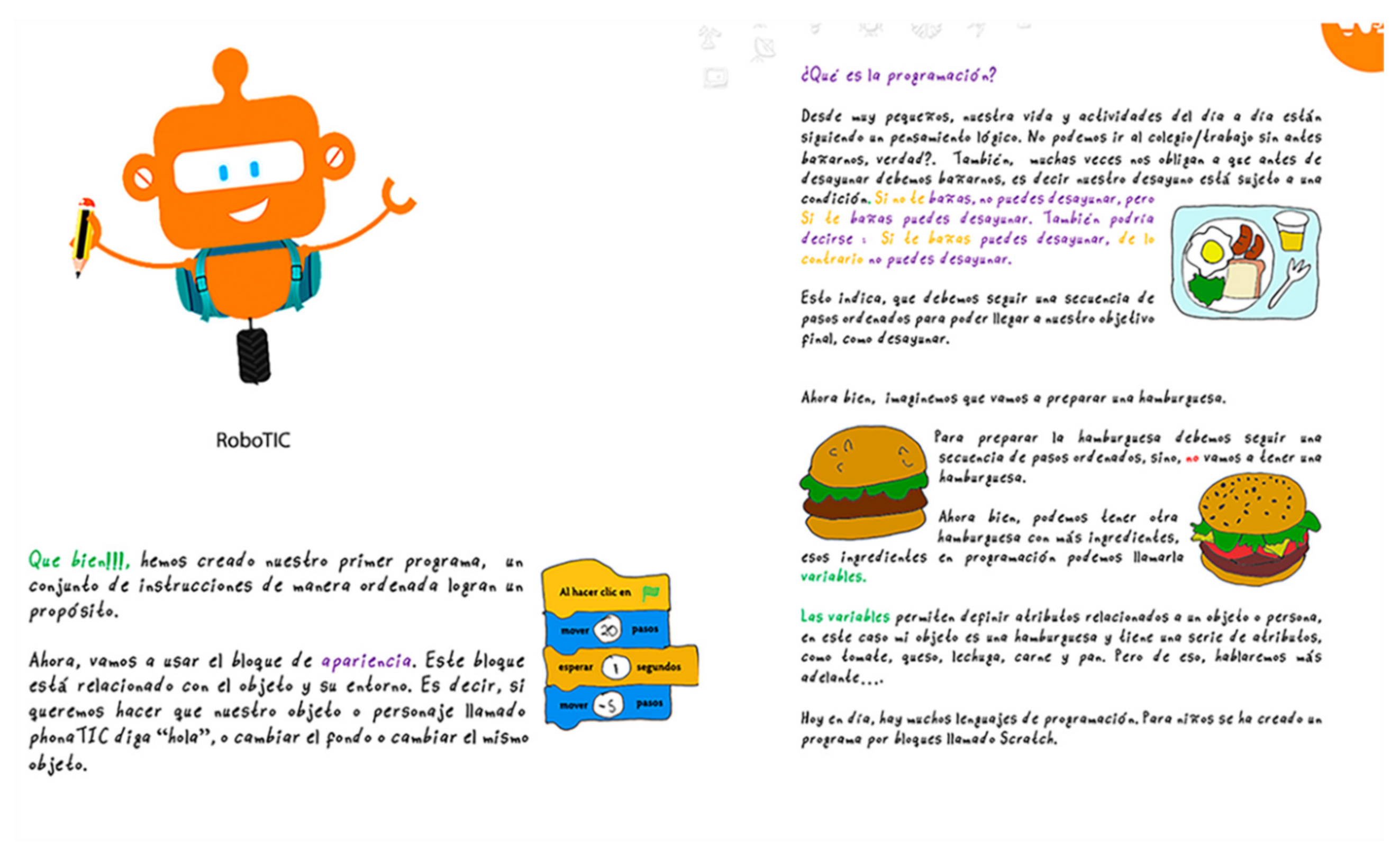
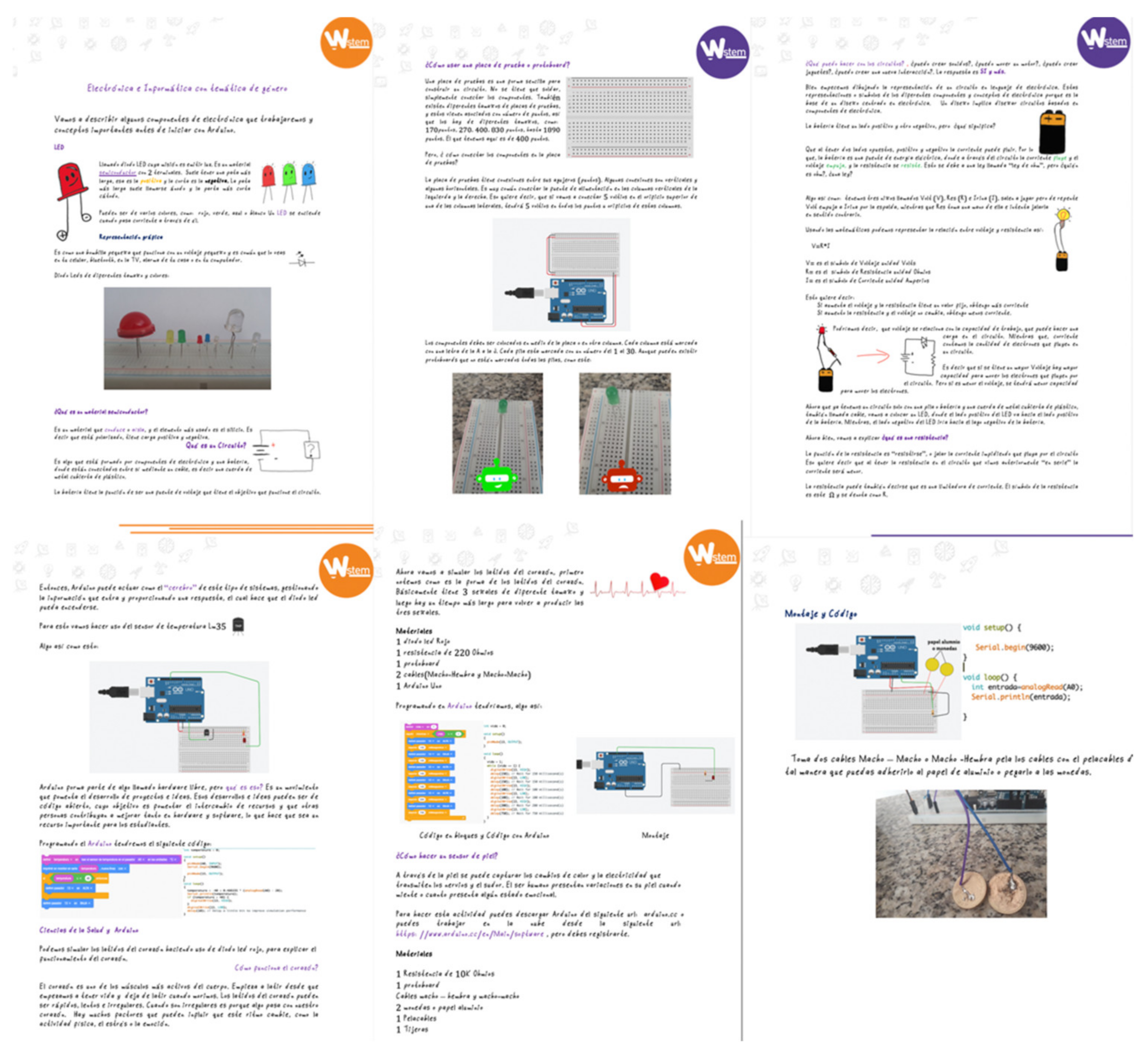
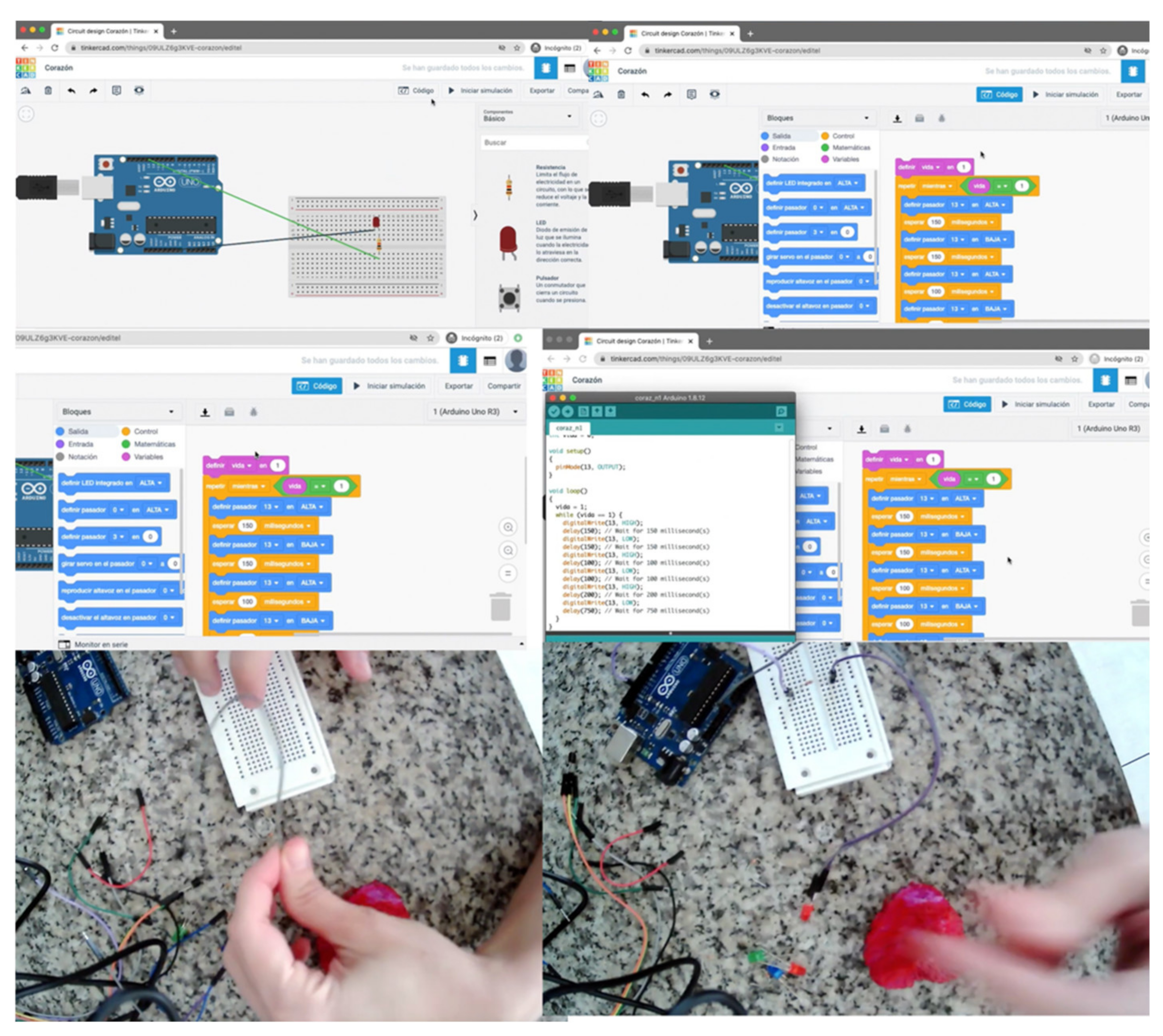
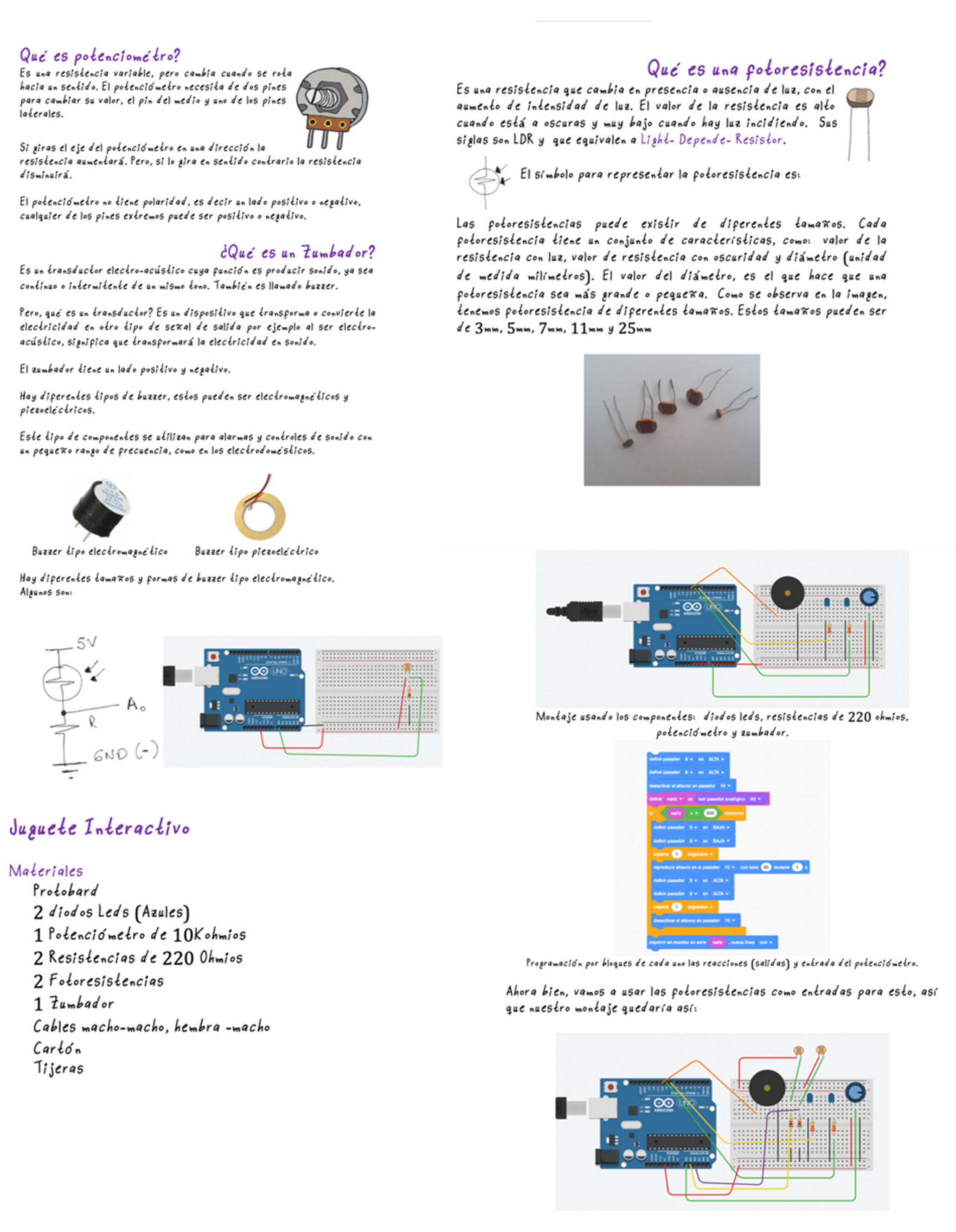

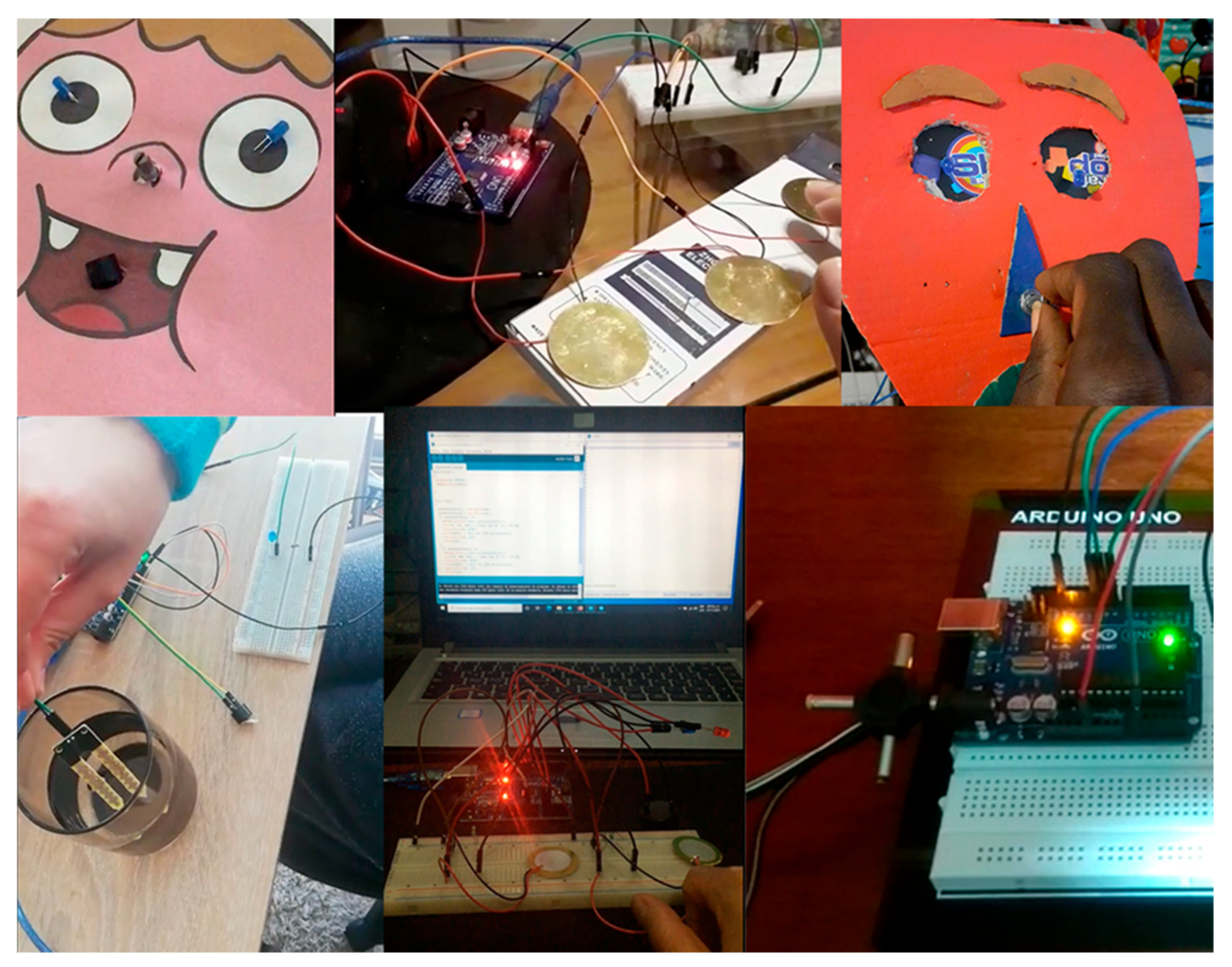
| Source | Interests |
|---|---|
| Michael et al. [71] | The girls showed interest in the use of tangible interfaces. |
| Su et al. [72] | The women showed interest in artistic areas. |
| Yamtinah et al. [73] Makarova et al. [74] | Women showed interest in helping people. In STEM areas, women lost interest very quickly in the areas of math and physics. |
| Women are more interested in areas of health. | |
| Negrini et al. [75] | Robots tend to be of greater interest to boys, due to their greater interest in technical skills. |
| Shaqiri et al. [76] | Differences in visual perception, are usually more visual. |
| 1. Basic Components | 1.1. Definition of Microcontrollers (Arduino) | basic |
| 1.2. What is a circuit? (Voltage and electricity) | basic | |
| 1.3. Leds | ||
| 1.4. Resistors | basic | |
| 1.5. Jumpler Cables | basic | |
| 1.6. How to make assemblies with a Protoboard? | basic | |
| 2. Sensors (inputs) | 2.1. definition perception | basic |
| 2.2. Light based sensors | basic | |
| 2.3. Temperature | basic | |
| 2.4. Humidity 2.5. Pressure | basic | |
| 3. Responses (outputs, Actuators, electronic components) | 3.1. Visual feedback 3.2. Audio feedback | basic |
| 5. Programming concepts | 5.1. What is programming? | basic |
| 5.2. Basic Aspects (data types, variables and propositional logic) | basic | |
| 6. Control statements | 6.1. Conditional sentences | basic |
| 6.2. Repetitive sentences | basic | |
| 6.3. Variables | basic | |
| 6.4. Operators | basic |
| Workshop | Description | Skills | Tool(s) |
|---|---|---|---|
| Interactive stories | Introduction to programming concepts through storytelling. | Technology use, problem solving | Scratch |
| Medical sciences and electronics | Introduction to electronics concepts, such as: protoboard, Arduino UNO, Jumper cables, Leds diode and resistors. | Technology use, Problem solving, and creativity | TinkerCad Arduino |
| Interactive toy | Using basic electronics components to build a face that can simulate reactions or emotions. Visual, tactile, and auditory responses are worked on. | Technology use, Problem solving, and creativity | TinkerCad Arduino |
| Music and electronics | Introduction to music concepts and piezoelectric sensor. | Technology use, Problem solving, and creativity | TinkerCad Arduino |
| Smart planter | Using temperature and humidity sensors to build a low-cost smart plant monitor. | Technology use, Problem solving, and creativity | TinkerCad Arduino |
| Sub-Scale | Item |
|---|---|
| Interest |
|
| Curiosity |
|
Publisher’s Note: MDPI stays neutral with regard to jurisdictional claims in published maps and institutional affiliations. |
© 2022 by the author. Licensee MDPI, Basel, Switzerland. This article is an open access article distributed under the terms and conditions of the Creative Commons Attribution (CC BY) license (https://creativecommons.org/licenses/by/4.0/).
Share and Cite
Cano, S. A Methodological Approach to the Teaching STEM Skills in Latin America through Educational Robotics for School Teachers. Electronics 2022, 11, 395. https://doi.org/10.3390/electronics11030395
Cano S. A Methodological Approach to the Teaching STEM Skills in Latin America through Educational Robotics for School Teachers. Electronics. 2022; 11(3):395. https://doi.org/10.3390/electronics11030395
Chicago/Turabian StyleCano, Sandra. 2022. "A Methodological Approach to the Teaching STEM Skills in Latin America through Educational Robotics for School Teachers" Electronics 11, no. 3: 395. https://doi.org/10.3390/electronics11030395






